Great Designs for Container Groupings
If your single containers are ready to mingle, start thinking about clustering them together

It’s hard to fail with a group of containers. A group of any size, from a simple pair to a great many, can improve any outdoor space. Open patios and decks become soft and intimate when pots are placed around them. A straight and simple outdoor path becomes a sort of allée if lined with containers—a formal one with certain plants or an informal one with others. You never know what you might come up with by placing one pot next to another or a certain plant among others. Once you start experimenting, you’ll notice the many places where a container grouping might look great.
Coordinate bright hues
This colorful collection of pots introduces viewers to a vivid color scheme in the beds behind it, mainly through blue flowers. To retain individuality, however, the pots get exclusive rights to colors such as magenta, pink, and chartreuse.
- Canna (Canna cv., USDA Hardiness Zones 8–11)
- ‘Versa Lime’ coleus (Solenostemon scutellarioides ‘Versa Lime’, Zones 12–13)
- ‘Colorcade Violet’ ivy geranium (Pelargonium peltatum ‘Colorcade Violet’, Zone 11)
- ‘Blue Zephyr’ swan river daisy (Brachyscome ‘Blue Zephyr’, Zones 9–11)
- Madeira™ Cherry Red argyranthemum (Argyranthemum frutescens ‘Bonmadcher’, Zones 10–11)
- Snow Princess® alyssum (Lobularia ‘Inlbusnopr’, annual)
- ‘Pink Chaos’ coleus (Solenostemon scutellarioides ‘Pink Chaos’, Zones 12–13)
- ‘Flamenco Cha Cha’ cuphea (Cuphea llavea ‘Flamenco Cha Cha’, Zones 9–11)
- ‘Religious Radish’ coleus (Solenostemon scutellarioides ‘Religious Radish’, Zones 12–13)
- Snowstorm® Blue bacopa (Sutera cordata Snowstorm® Blue, Zones 9–11)
Formal flanking
The combination of papyrus and urns always looks elegant, but when doubled and placed on either side of this ornamental boulder, these container designs work with each other in a striking formal duet. They bring attention to the rocky corner, which might have looked less spectacular without them.
- King Tut® papyrus (Cyperus papyrus ‘King Tut’, Zone 11)
- ‘Big Red Judy’ coleus (Solenostemon scutellarioides ‘Big Red Judy’, Zones 12–13)
- ‘Versa Lime’ coleus (Solenostemon scutellarioides ‘Versa Lime’, Zones 12–13)
- ColorBlaze® Kingswood Torch coleus (Solenostemon scutellarioides ’Kingswood Torch’, Zones 12–13)
- ‘Solenia Dark Pink’ begonia (Begonia ‘Solenia Dark Pink’, Zones 12–13)
- ‘Sweet Caroline Light Green’ sweet potato vine (Ipomoea batatas ‘Sweet Caroline Light Green’, Zone 11)
- ‘Sweet Caroline Purple’ sweet potato vine (Ipomoea batatas ‘Sweet Caroline Purple’, Zone 11)
- ‘Solenia Red’ begonia (Begonia ‘Solenia Red’, Zones 12–13)
Subtle variations on a common theme
Container arrangements don’t have to be grandiose to be effective. This trio of like-size pots relies on tonal and textural interest for success. Each is green but adds a different texture and shade of the color to the collection: leathery jade from the hosta, feathery emerald from the fern, and paper-thin blades of lime from the Japanese forest grass.
- ‘Fortunei Aureomarginata’ hosta (Hosta ‘Fortunei Aureomarginata’, Zones 3–9)
- Hedge fern (Polystichum setiferum, Zones 6–9)
- ‘All Gold’ Japanese forest grass (Hakonechloa macra ‘All Gold’, Zones 5–9)
Similar baskets and pots fill a view
To completely fill a space, use overhangs by stringing up a basket that mimics what’s happening below it. With purple and green up and down, who notices the boring fence and siding?
- Snowstorm® Blue bacopa (Sutera cordata Snowstorm® Blue, Zones 9–11)
- Coleus (Solenostemon scutellarioides cvs., Zones 12–13)
- Sweet potato vines (Ipomoea batatas cvs., Zone 11)
- Mystic Spires salvia (Salvia ‘Balsalmisp’, Zones 7–10)
- ‘Tea Cup’ elephant’s ear (Colocasia esculenta* ‘Tea Cup’, Zones 8–11)
- Purple-leaved Japanese parsley (Cryptotaenia japonica f. atropurpurea, Zones 4–7)
- ‘Zwartkop’ aeonium (Aeonium arboreum ‘Zwartkop’, Zones 9–11)
- Umbrella plant (Cyperus alternifolius, Zones 9–11)
- Molten Lava™ sorrel (Oxalis vulcanicola ‘Molten Lava’, Zones 9–11)
- Creeping wire vine (Muehlenbeckia axillaris, Zones 8–10)
A hot color diffused by a cool one

These red plants create warm, rich masses of color atop their pots: a New Zealand flax and a petunia in the tallest, a Cape fuchsia and a coleus in the middle, and burgundy hens and chicks in the shortest. To make them more approachable, however, these containers were stuffed into their sides with silver plants, like a dusty miller and a licorice plant, to diffuse brightness as the eye passes over these pots.
- Cider gum (Eucalyptus gunnii, Zones 8–10)
- ‘Sundowner’ New Zealand flax (Phormium ‘Sundowner’, Zones 8–10)
- Silver plectranthus (Plectranthus argentatus, Zones 10–11)
- Coleus (Solenostemon scutellarioides cvs., Zones 12–13)
- ‘Petite Licorice’ licorice plant (Helichrysum petiolare ‘Petite Licorice’, Zones 9–10)
- Potunia® Papaya petunia (Petunia ‘Papaya’, annual)
- Leatherleaf sedge (Carex buchananii, Zones 6–9)
- Croftway™ Coral Princess Cape fuchsia (Phygelius ‘Croftway Coral Princess’, Zones 7–9)
- Silver Cascade® dusty miller (Artemisia stelleriana* ‘Silver Cascade’, Zones 3–7)
- Jamesbrittenia JB Party® Dark Coral bacopa (Sutera Jamesbrittenia JB Party® Dark Coral, Zones 10–11)
- Hens and chicks (Sempervivum spp. and cvs., Zones 4–11)
- ‘Valerie Finnis’ artemisia (Artemisia ludoviciana ‘Valerie Finnis’, Zones 4–9)
Find common ground
One wouldn’t expect this Japanese forest grass, this coleus, and this begonia to share a corner so peacefully. But they do, thanks to matching terra-cotta containers in graduated sizes—a common base that allows the diverse plants they hold to blend together.
- Bellfire® begonia (Begonia boliviensis Bellfire®, Zones 10–11)
- Black stem elephant’s ear (Colocasia esculenta* ‘Fontanesii’, Zones 8–11)
- ‘Electric Lime’ coleus (Solenostemon scutellarioides ‘Electric Lime’, Zones 12–13)
- ‘Sweet Caroline Bronze’ sweet potato vine (Ipomoea batatas ‘Sweet Caroline Bronze’, Zone 11)
- ‘Aureola’ Japanese forest grass (Hakonechloa macra ‘Aureola’, Zones 5–9)
- Fusion Infrared Apricot exotic impatiens (Impatiens ‘Balfusinred’, annual)
Not-quite-identical pots are a puzzle
These designs are nearly doubles: boxy pots, green spillers, and purple plants atop. But the containers stand at different heights, the spillers are not the same plant, and the purple clumps on top are not the same plants. It’s clever, like a child’s can-you-spot-the-differences puzzle.
- Purple fountain grass (Pennisetum setaceum* ‘Rubrum’, Zones 8–11)
- Royal Glissade® coleus (Solenostemon scutellarioides ‘Royal Glissade’, Zones 12–13)
- Illusion® Midnight Lace sweet potato vine (Ipomoea batatas ‘NCORNSP011MNLC’, Zone 11)
- Purple sage (Salvia officinalis ‘Purpurascens’, Zones 5–8)
- Variegated ground ivy (Glechoma hederacea* ‘Variegata’, Zones 4–9)
- ‘Dipt in Wine’ coleus (Solenostemon scutellarioides ‘Dipt in Wine’, Zones 12–13)
- ‘Sweet Caroline Bewitched’ sweet potato vine (Ipomoea batatas ‘Sweet Caroline Bewitched’, Zone 11)
- Myrtle spurge (Euphorbia myrsinites, Zones 5–8)
Pick plants with habit in mind
‘Lemon Lime’ dracaena lets its leaves hang in soft arcs. Because of this habit, it’s the perfect neighbor for small plants, such as ‘Solenia Red’ begonia and these coleus, which can be nestled under the dracaena’s fronds.
- ‘Lemon Lime’ dracaena (Dracaena ‘Lemon Lime’, Zone 13)
- Radical Wonder™ coleus (Solenostemon scutellarioides ‘Radical Wonder’, Zones 12–13)
- ‘Big Red Judy’ coleus (Solenostemon scutellarioides ‘Big Red Judy’, Zones 12–13)
- ‘Solenia Red’ begonia (Begonia ‘Solenia Red’, Zones 12–13)
- ‘Sweet Caroline Light Green’ sweet potato vine (Ipomoea batatas ‘Sweet Caroline Light Green’, Zone 11)
Two takes on a great combo

They’re nearly the same combinations: ‘Zwartkop’ and ‘Velour’ aeoniums stand tall with their petal-like leaves, surrounded by other succulents such as blue chalk sticks and ‘Ogon’ sedum. But while the window box sits in a formal, regimental pattern, the urn is made more casual by the addition of less-formal-looking plants, such as firesticks and ‘Purpurea’ dagger plant.
- ‘Velour’ aeonium (Aeonium arboreum ‘Velour’, Zones 9–11)
- Blue chalk sticks (Senecio serpens, Zones 9–11)
- ‘Ogon’ sedum (Sedum makinoi ‘Ogon’, Zones 6–9)
- ‘Zwartkop’ aeonium (Aeonium arboreum ‘Zwartkop’, Zones 9–11)
- Firesticks (Euphorbia tirucalli ‘Rosea’, Zone 11)
- ‘Purpurea’ dagger plant (Yucca aloifolia ‘Purpurea’, Zones 12–13)
- Burro’s tail (Sedum morganianum, Zone 11)
- Painted echeveria (Echeveria nodulosa, Zones 12–13)
- ‘Capri’ echeveria (Echeveria ‘Capri’, Zones 12–13)
Don’t match plants—match traits
Shiny greens, deep purples, and trailing silvers come from the many different plants in both of these containers, creating harmony out of the numerous varieties in the pots.
- Red Abyssinian banana (Ensete ventricosum ‘Maurelii’, Zones 9–11)
- ‘Gryphon’ begonia (Begonia ‘Gryphon’, Zones 12–13)
- ‘Silver Falls’ dichondra (Dichondra argentea ‘Silver Falls’, Zones 10–11)
- Sweet potato vines (Ipomoea batatas cvs., Zone 11)
- Coleus (Solenostemon scutellarioides cvs., Zones 12–13)
- ‘Elegance Burgundy’ geranium (Pelargonium ‘Elegance Burgundy’, Zone 11)
- Honey bush (Melianthus major, Zones 8–11)
- Superbells® Blackberry Punch calibrachoa (Calibrachoa ‘USCAL68604’, annual)
- ‘Tea Cup’ elephant’s ear (Colocasia esculenta* ‘Tea Cup’, Zones 8–11)
- Fountain rush (Elegia capensis, Zones 10–11)
- ‘Valerie Finnis’ artemisia (Artemisia ludoviciana ‘Valerie Finnis’, Zones 4–9)
- Variegated ground ivy (Glechoma hederacea* ‘Variegata’, Zones 4–9)
Clusters of pots offer respite
Thanks to the containers around it, this chair becomes a private place. Although the low petunia, short coleus, and sparse firesticks don’t screen the chair, they provide a cheery visual barrier.
- Acapulco™ Salmon & Pink hummingbird mint (Agastache Acapulco™ Salmon & Pink, Zones 6–9)
- Firesticks (Euphorbia tirucalli ‘Rosea’, Zone 11)
- Potunia® Papaya petunia (Petunia ‘Papaya’, annual)
- Bronze Age™ coleus (Solenostemon scutellarioides ‘Bronze Age’, Zones 12–13)
- ‘Chameleon’ houttuynia (Houttuynia cordata ‘Chameleon’, Zones 5–11)
- King Tut® papyrus (Cyperus papyrus ‘King Tut’, Zone 11)
- Mint bush (Prostanthera rotundifolia, Zone 11)
Big and small pots call for big and small plants
A large container surrounded by smaller ones is a lovable site, like a hen surrounded by chicks. To balance the size difference, plant one large plant in each small pot and many smaller plants in the big one.
- ‘Purple Majesty’ millet (Pennisetum glaucum ‘Purple Majesty’, Zones 8–11)
- Scarlet monkey flower (Mimulus cardinalis, Zones 6–9)
- Tropicanna® canna (Canna indica ‘Phasion’, Zones 8–11)
- ‘Cherry Cola’ heuchera (Heuchera ‘Cherry Cola’, Zones 4–9)
- Coleus (Solenostemon scutellarioides cvs., Zones 12–13)
- ‘Vesuvius Red’ flowering maple (Abutilon × hybridum ‘Vesuvius Red’, Zones 9–11)
- Royal Hawaiian® ‘Diamond Head’ elephant’s ear (Colocasia esculenta* ‘Diamond Head’, Zones 8–11)
- ‘Frosted Chocolate’ corokia (Corokia × virgata ‘Frosted Chocolate’, Zones 8–10)
- ‘Hansel’ rhododendron (Rhododendron ‘Hansel’, Zones 6–9)
- Callie® Orange Sunrise calibrachoa (Calibrachoa ‘Callie Orange Sunrise’, annual)
Limited color choices free up other details

This design uses reds, greens, and a few deep purples exclusively, which allows differently shaped plants to share the same window box and urn. Texture and shape are varied but toned down and connected by color. For an extra dash of the exotic, ‘Zwartkop’ aeonium provides its pot with a succulent burst, while Baby Tut® umbrella grass tops off its container in a similar explosion.
- ‘Wilma’s Gold’ trailing golden rosemary (Rosmarinus officinalis ‘Wilma’s Gold’, Zones 8–11)
- Superbells® Coralberry Punch calibrachoa (Calibrachoa ‘USCAL66501’, annual)
- ‘Flamingo’ New Zealand flax (Phormium cookianum ‘Flamingo’, Zones 8–11)
- Bronze Age™ coleus (Solenostemon scutellarioides ‘Bronze Age’, Zones 12–13)
- ‘Zwartkop’ aeonium (Aeonium arboreum ‘Zwartkop’, Zones 9–11)
- Napoleon™ papyrus (Cyperus papyrus ‘Napoleon’, Zones 9–11)
- Sweet potato vines (Ipomoea batatas cvs., Zone 11)
- Flowering maple (Abutilon cv., Zones 8–11)
- Baby Tut® umbrella grass (Cyperus involucratus ‘Baby Tut’, Zones 9–11)
- Elephant’s ear (Alocasia sp., Zone 11)
Texture and patterns mimic the home
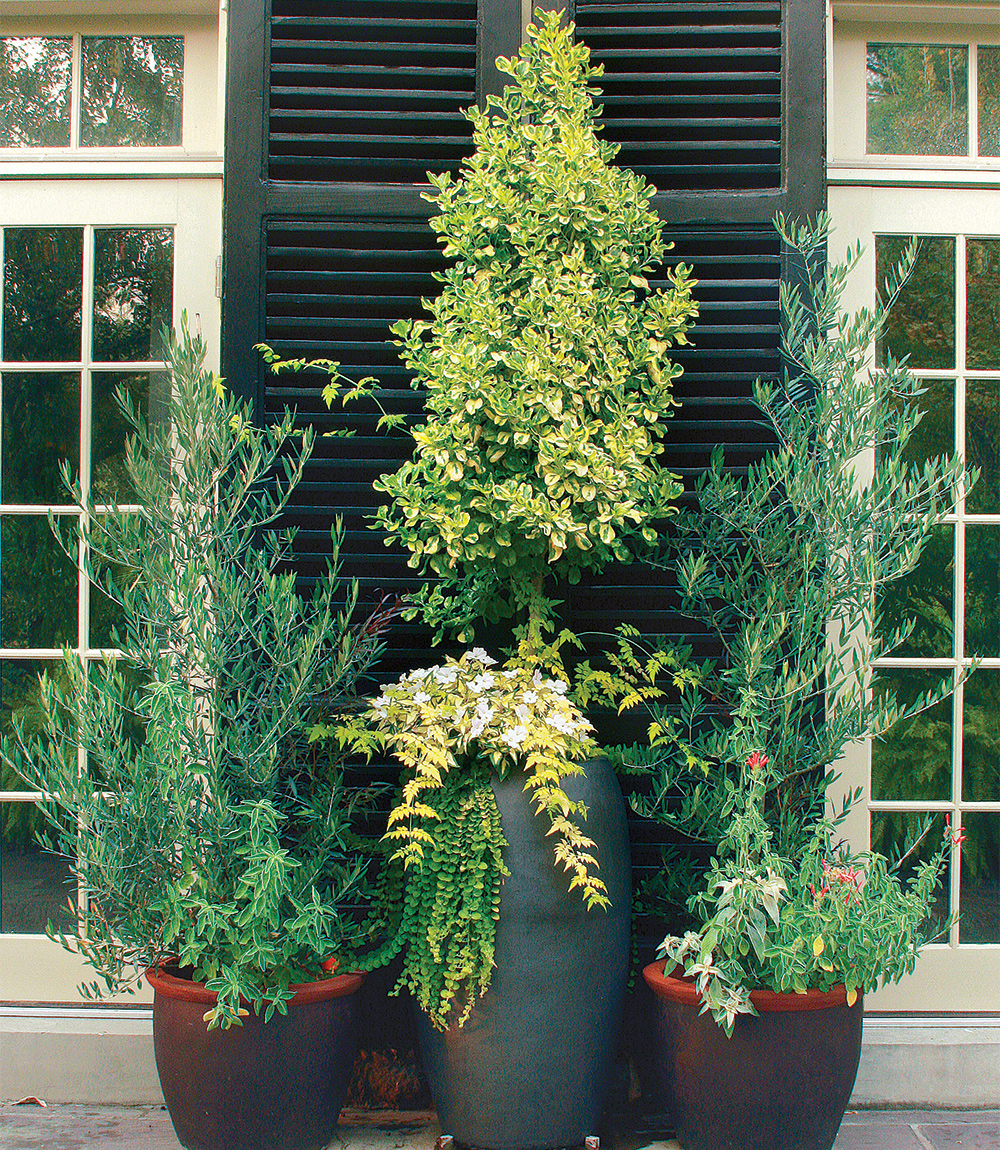
This group’s arrangement is prescribed by the home: Open windows flank solid shutters, so the airy olive flanks a beautifully dense coprosma, which happens to stand out beautifully against the dark, slatted surface.
- ‘Taupata Gold’ coprosma (Coprosma repens ‘Taupata Gold’, Zones 8–10)
- Fiona Sunrise™ jasmine (Jasminum officinale ‘Frojas’, Zones 9–10)
- Golden creeping Jenny (Lysimachia nummularia* ‘Aurea’, Zones 4–8)
- ‘Picual’ olive (Olea europaea* ‘Picual’, Zones 8–10)
- Dicliptera (Dicliptera suberecta, Zone 13)
Designed by Dan Benarcik for Chanticleer in Wayne, Pennsylvania
Hang groups out for a lush look

These massive hanging baskets are just overgrown enough to make the exterior feel stately yet wild. Using two baskets adds a formal touch to the scene, but growing creepers up the hanging chain and over each basket brim helps tone down the formality for something unique and salient.
- Flowering maple (Abutilon cv., Zones 8–11)
- ‘Tahiti’ Jacob’s coat (Acalypha wilkesiana ‘Tahiti’, Zones 12–13)
- Louteridium (Louteridium donnell-smithii, annual)
- ‘Taupata Gold’ coprosma (Coprosma repens ‘Taupata Gold’, Zones 8–10)
- ‘Rita’s Gold’ Boston fern (Nephrolepis exaltata ‘Rita’s Gold’, Zone 11)
- Peperomia (Peperomia sp., Zone 13)
- ‘Snap Daddy Yellow’ snapdragon (Antirrhinum majus ‘Snap Daddy Yellow’, annual)
- Lemon vine (Pereskia aculeata ‘Godseffiana’, Zone 13)
- Golden creeping Jenny (Lysimachia nummularia* ‘Aurea’, Zones 4–8)
Designed by Dan Benarcik for Chanticleer in Wayne, Pennsylvania
*These plants are considered invasive in some areas. Please check invasiveplantatlas.org or your state’s list of invasive plants for more information.
—Todd Holloway is the owner of Pot Inc., a plant design firm, and creates premium landscape and garden planters in Vancouver, British Columbia.
Photos, except where noted: Joshua McCullough/phytophoto.com
Fine Gardening Recommended Products

Buffalo-Style Gardens: Create a Quirky, One-of-a-Kind Private Garden with Eye-Catching Designs
Fine Gardening receives a commission for items purchased through links on this site, including Amazon Associates and other affiliate advertising programs.

Attracting Beneficial Bugs to Your Garden, Revised and Updated Second Edition: A Natural Approach to Pest Control
Fine Gardening receives a commission for items purchased through links on this site, including Amazon Associates and other affiliate advertising programs.

Corona® Multi-Purpose Metal Mini Garden Shovel
Fine Gardening receives a commission for items purchased through links on this site, including Amazon Associates and other affiliate advertising programs.



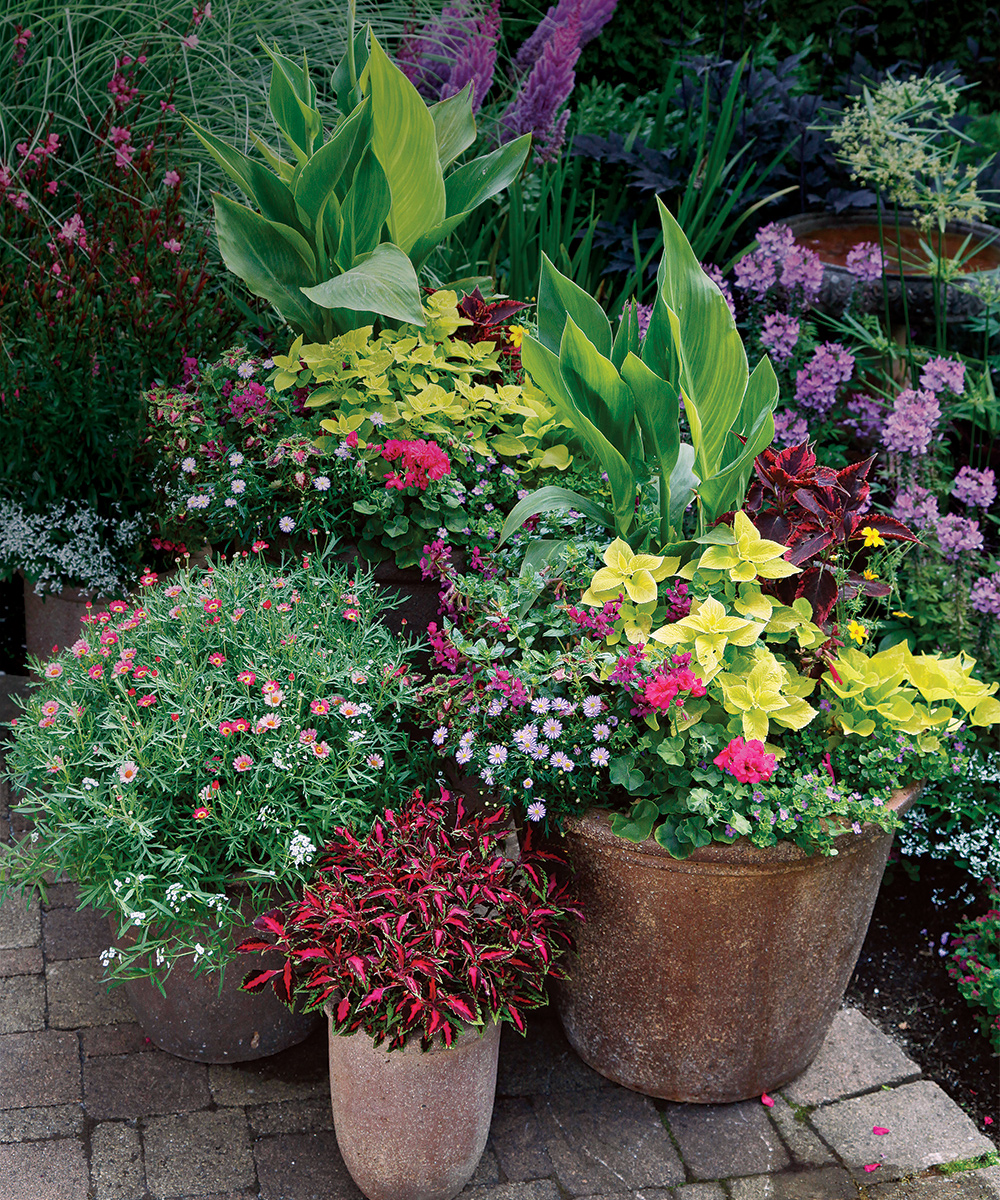



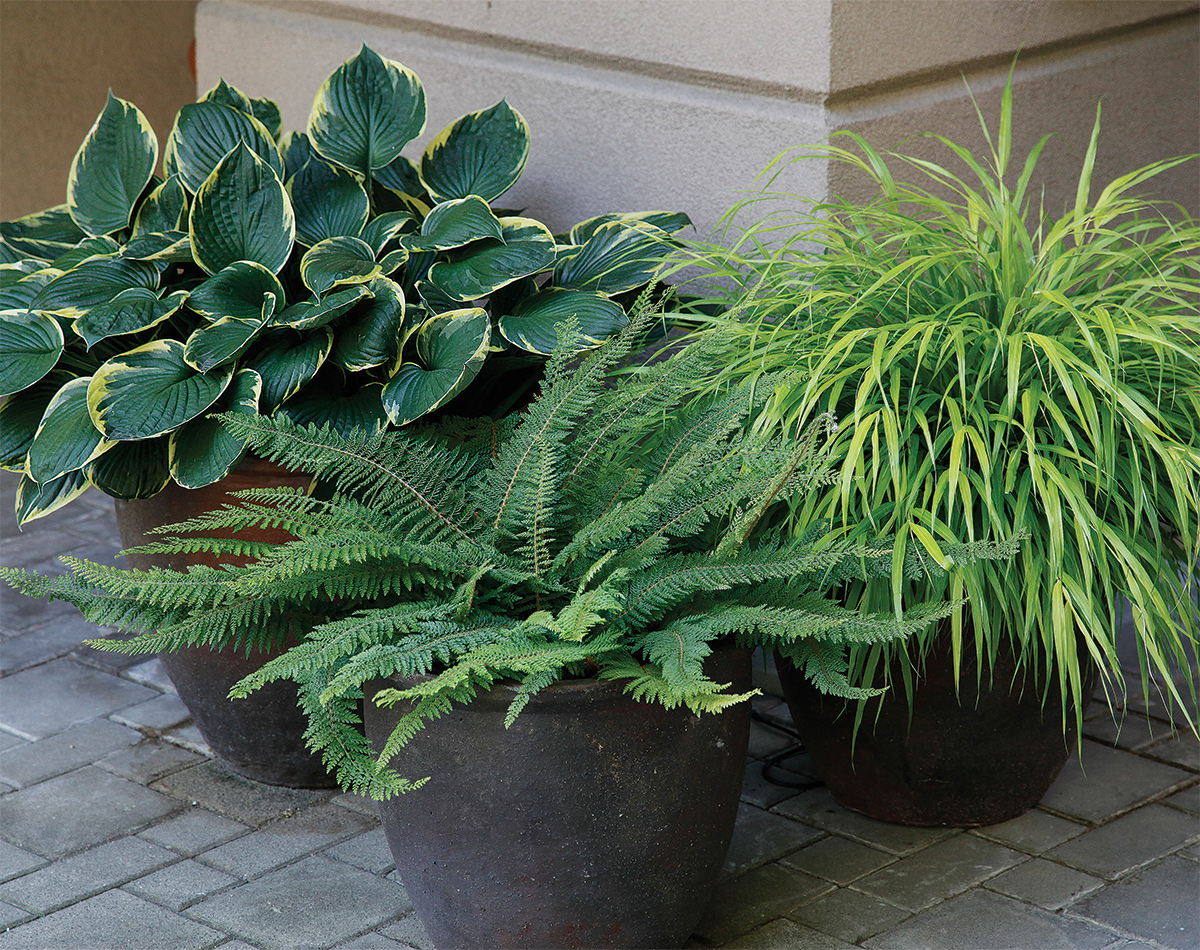





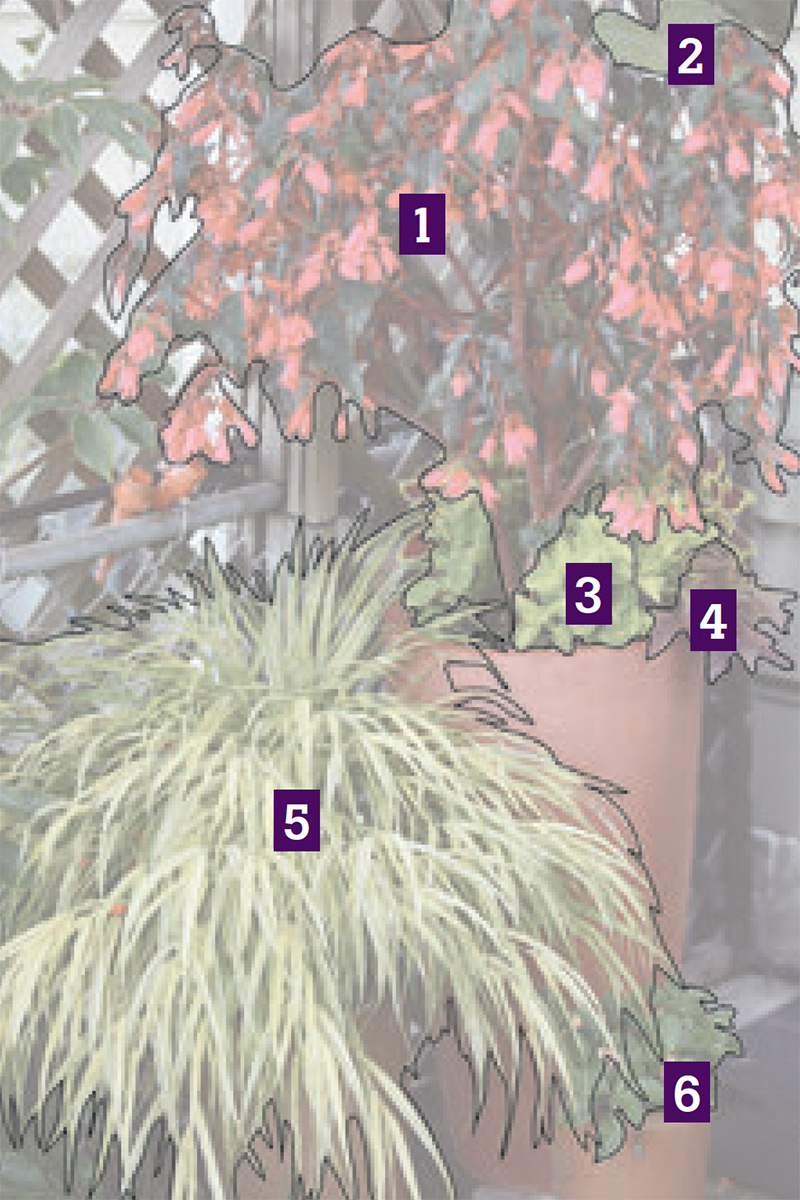







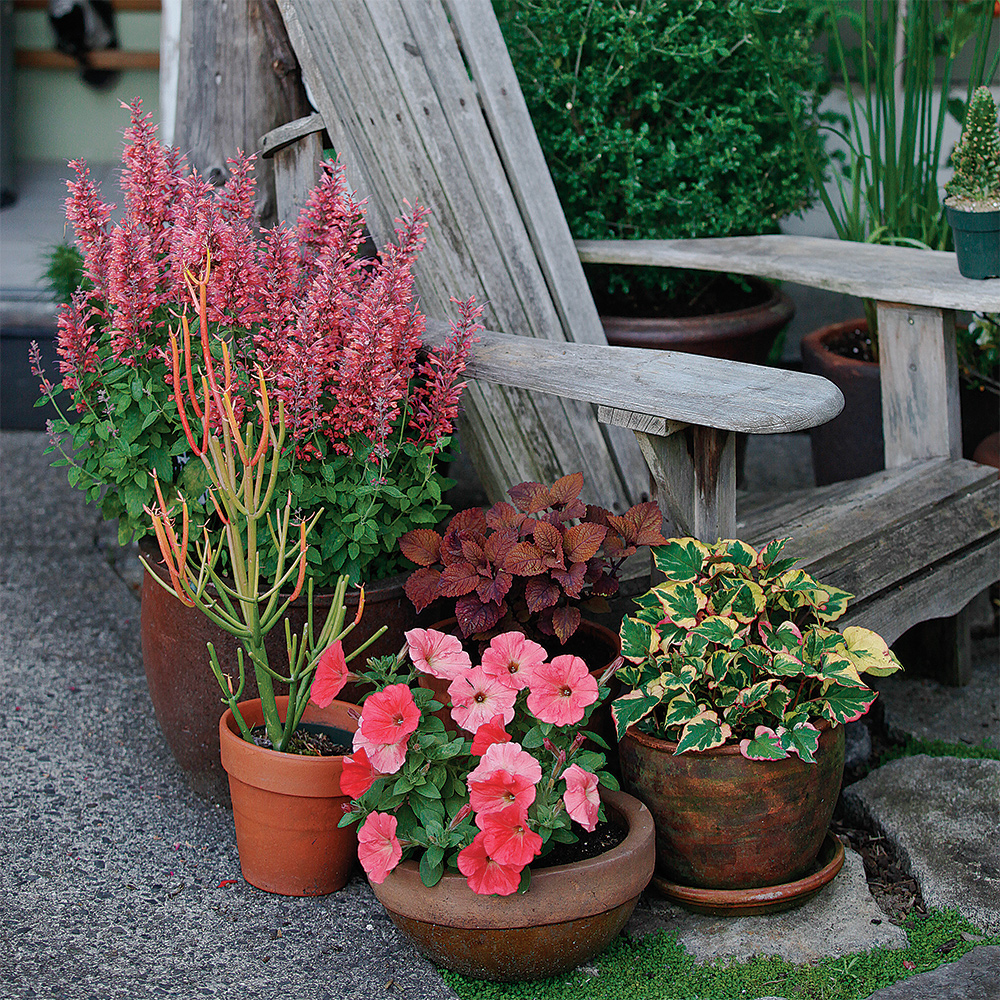




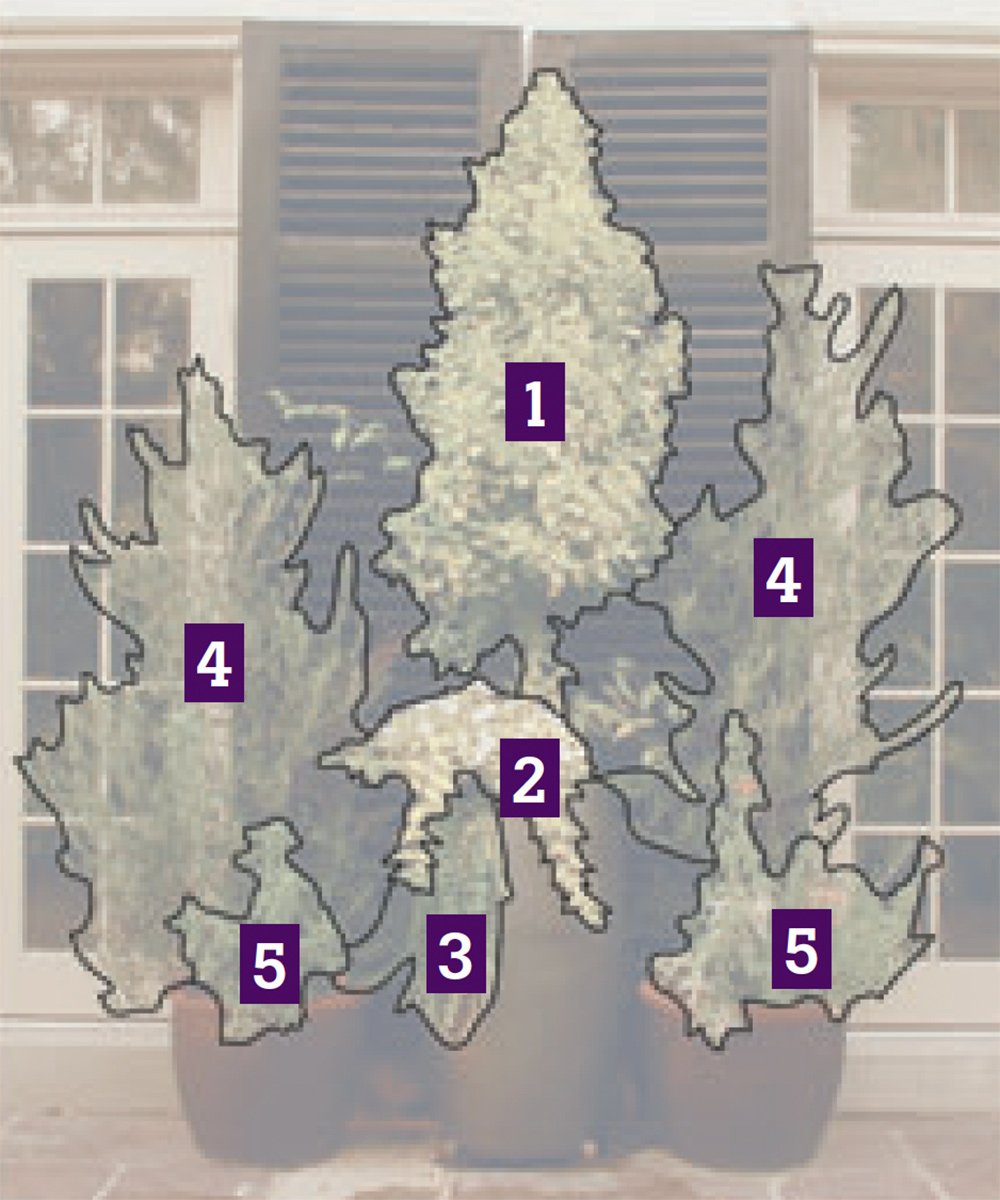





Comments
Log in or create an account to post a comment.
Sign up Log in